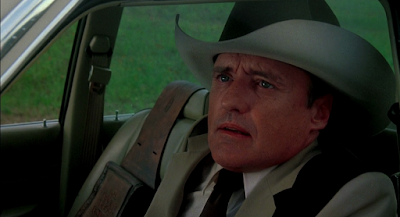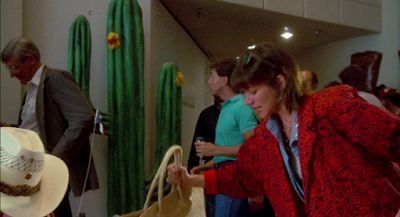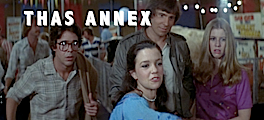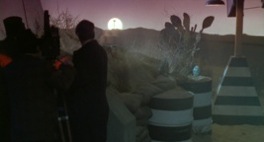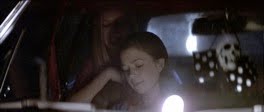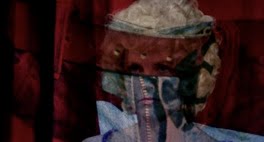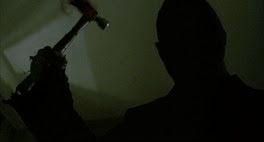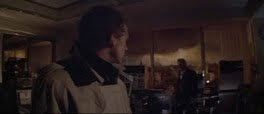Let's imagine some fantastical alternate universe where Hooper was not
relegated to the realm of horror cinema or to the excesses of the
contemporaneous Hollywood era - for instance, in regard to the latter, the 1980s, that point at
which even the most auteur-driven epic or deliberately throwback cinema
could hardly think to reclaim the structural simplicity (and occasional
spirituality) of vintage storytellers like Ford or Wyler or McCarey (or
even Le Roy) — mainstream but artistically notable producers, of the early 1930s through 40s, of seminal American cinema text. The riches of the early era go on, of course,
through sheer virtue of "classical formalism," that je ne sais quoi of olden movies which encompasses the
combined modes of erstwhile formal techniques, narratology, and an innate
structuralism, made the elegant standard simply through earliness, primitiveness of analog methods, and a certain naivete (on the part of the audience) and creative, literary innocence (an innocence almost embodied by the rigid stewardship of the studio system, both restricting and directing, hampering and allowing to flourish through a populist refraction the craftsmen it employed). It is the lattermost aspect that most likely constitutes the capital-V
virtue, if any, of a monolithic "Classical cinema," going beyond the
individual auteurs' formalisms, finding its root in the directness and clarity of the storytelling. This early popular structuralism is premodern, only broadly psychological, potent through compaction, and
emphatically moralistic - neither fascistic nor democratic (when at its best behavior), just uniformly traditionalist, even as the crème de la crème artists propended to take their analog visual forms to greater creative heights (this would be the "individual formalisms" mentioned earlier).
Deliberately narrowing my focus
on the explicitly Hollywood-bred and a particular American-ness, in this time of classical or primitive narrative film creation we can cover a range moving from the
high auteur (Ford) to the journeyman (Le Roy), plus everything in between
(such as the compromised Wyler, and, were it not for the spectrum I was going for, Preston Sturges subbing in for McCarey, Sturges the more unambiguous auteur of America's lighter
side, who is America's homegrown Lubitsch) and still unite them through
their era and the poetical force of their early creation of prototypical, foundational (albeit from the previous foundational sources of storytelling: myth, the dramatic arts, the novel) and naive
narratives: elemental/economic, "simple"/quaint (pre-modern,
pre-postmodern), and structural (structuralism before "Structuralism"). Tobe Hooper's contemporary importance is to be found
in his re-institution of elements of these things important to the
classical commercial work into his own work during the impurest of times, with a
hyper-awareness of the elemental, the simple, and the structural forms
that informed the cultural cinema of the past and which now constantly separate
his work from most of the films surrounding it. This is all without
falling into the temptation and circularity of homage; in other words,
that is, while making his thoroughly modern work.
Far beyond the rose-colored glasses of paltry and selective nostalgia, it is less tragedy as it is simply the natural course of a medium that it spends through its outmoded styles (no less an accelerated one like film, inheritor of the art and art histories that preceded it, and the first exclusively post-industrial and Marxist-adjacent art form). Film, as a commercial and storytelling art, and more than any other art form, has always been rigged to evolution: moving from the technological (film's "great classical period," through Western eyes, which I currently concern myself with, was already preceded by a great modernist period, through Soviet eyes) to the expressive (and back again to the technological), the classical to the New Wave, from the pure cinema (think Stroheim and Gance) to the ever more complicated, enhanced, and thus novelistic. With each era, it seems the things that are lost are the simplicities, with the desire shifting from honoring traditions past to innovating and rethinking things for the future and for developing tastes. At one point in the past, all that was called for was a story to be told, and now, such exigencies - not meant exclusively negatively, for this includes every step we made towards the fully-realized cinema, one of sound and color and grander geometries - as dramatic realism, psychological realism (this would be Truffaut's woe of the overly-aggressive "literary" cancer infecting film's poetic inexactitudes), and an ever-growing inventory of commercial accessories are expected, while the styles and principles of the past fall by the wayside, becoming old-fashioned and passé by nature. But their lessons can be passed on, reworked. Revitalized.
Now imagine that alternate universe, where Hooper would have been able to create his own The Egyptian (Michael Curtiz, 1957), a film of some moral force that he recently named a favorite of his (of the particular moment, circa about a year ago), and which we must not neglect is a film in its own way indebted to the corruptible tastes of its time - namely its lumbering, literary, and pseudo-scriptural bombast tied to the "DeMillification" of Hollywood cinema of that era. Still, in my personal purview, a middle-of-the-road Curtiz moral epic seems purer, more sincere of purpose, and injected with more clarity than any of the epic filmmaking of the late 70s or 80s (think Cimino, melding classicalism and modernism to a disorienting degree, Coppola, melding classicalism and postmodernism, or Lucas, amending to it all the commercialism). How at home Hooper would probably have felt in the more classical age of film, where the market still held some leeway for those filmmakers with no leg in the future, a future of "isms," but only a stubborn attachment to the narrative, formal, and moralistic simplicities of the past.
The Egyptian, Michael Curtiz, 1954
The Texas Chainsaw Massacre 2
is the Hooper film most attached to the trends of its era, but it
is still bolstered by Hooper's affinity for a film such as The Egyptian, a sense of emphatic dramatic/literary structures, often characterized by a clarity and simplicity (paradoxically found in the complications of narrative dimensionality, narrative richness, overly literary it may be in a Curtiz film, a drawback Hooper overcomes with his personal sense of a fabulist film work), that make
its storytelling resonate beyond the moment - perhaps not having the
spiritual and poetic instincts of Ford (which is something Hooper will
never have, having passed on it and bestowed such prodigal discipleship
to Spielberg), but in no negligible measure exhibiting the attention to
symbolic narratives and thematic/moral latticework that imbue the less
poetic, more hard-boiled and pragmatic Curtiz (a Continental implant brought to Hollywood,
as it turns out,
but no matter) with his storytelling purity, marked by plain and
forthcoming secular-humanist concerns and the realization of story
richly baked in these concerns. The moral layering of a purely secular or literary storytelling is paid
greater attention to than the servicing of a sphinxlike
instinct, the divine spark of a hand of a master (although such accessible material the latter
is for the hand of the theorist, it must be said). Ford is the
more personal author and thus greater artist than Curtiz. Curtiz is
the superior moralist. Hooper combines the personal with the impersonal,
the pre-modern with the modern (and the postmodern), the secular with the ecstatic (the religion being studio-era cinema), the structuralist
with personal formalism. Texas Chainsaw 2 suffers immediately from
being the Hooper film most "placeable" as part of its time, but it opens
up to dramatic, narrative, and ethical scrutiny in ways much more
classical: that is, in the clarity and precision of the dramatic
passages, Curtizian pragmatism melded with his modernist-gothic sensibilities. In other words, is Hooper a Ford man or a Curtiz man? He is a Curtiz man.
We
may cock an eyebrow at the 1986 slasher parody's alternately too
under-thought (modernist) and over-thought (postmodernist) antics -
partway encapsulated in the frantic cutting that occurs as Stretch is
chased by Lefty's vehicle in the "ribs" of Texas Battle Land, a galling
stab at a modern sort of expressionism that ultimately seems
there mostly to cover the tracks of the utter bareness of the plot, which the
film, at that point, has learned to embrace.
But, like Curtiz's stodgy, naive, and brashly pacifistic The Egyptian proving itself of more power and relevance now than The Ten Commandments (the Curtizian groundedness - some would dock it as anti-intellectuality, anti-poetry - and earnest Curtizian politics a
subversion of DeMille in the lending of a modern liberal sensibility to
the compulsory Christian-Messianic makeover of an old Egyptian tale, thus making it automatically favorable to DeMille's
almost anti-humanist grandiosity and evangelicalism), The Texas Chainsaw Massacre 2 subverts both its predecessor - yes, Texas Chain Saw 1
- and the slasher flicks it spawned by its thorougher service of a
narrative more classically narrativized and clearer in ethical structures and purpose than
it often has the freedom to let on, due to its nature as a product of the
80s slasher market (a la The Egyptian's crutch of its nature, white-washing and Hollywoodizing/Christianizing history). Hooper's affinity for The Egyptian
may find its disjunction at the pivotal level of form (Curtiz being far
too level-headed a filmmaker of the studio era to channel Hooper's
expressive modernisms), but he obviously responds to it on a
level of classical aesthetics, narrative clarity, secular-humanism, and ethical
earnestness.
TCM 2's
call-backs to the simplicities and moral directness of the past are
more buried than with the more freely allegorical and unique (that is,
unplaced in time) Lifeforce and The Funhouse, which boast
their old-fashioned/timeless sense of storytelling cohesiveness even
beneath all their postmodern irony, within stories conceived of in their
importance. Those two films are highly original conceptions of
themselves and their purposes: Lifeforce a story of "the genesis of mankind" - Hooper's own remarkable words - and The Funhouse
a collection of our petty life compartmentalized onto a criminal
fairground. Hooper always finds his way back to classical journeymen
like Curtiz with his subservience to dramatic/literary layers over poetic conceits, forgoing many stylistic avenues in order to find the moral
essence in purified story (then adapting this quainter method to harder,
more reflexive modern times, much like that similarly perpetrated by Hooper's
patron saint of neutrality-within-film, analysis-within-genre, and
clarity-above-all-else, Richard Fleischer). Both Hooper and Fleischer,
though, continued their work into and through the boom of the European
art-house in the 60s, and so, through cinematic cultural osmosis, would
occasionally meld their hard American expressiveness with brief lapses
into aesthetically challenging, symphonic, modernist sensibilities (e.g. The Texas Chainsaw Massacre, Mandingo).
This is all in defense of The Texas Chainsaw Massacre 2,
which plays out like a commercial horror film, but actually devotes
quite a bit of itself to sussing out the embedded dramatic structures of its
narrative, structure that grows tighter and more driving with each viewing, a bed
for a nest of pacifist subtext and narrative interrelations.


One such "commercial accessory" of the time and the genre is the "gore shot," here a lopped-off cranium sliding down its remaining lower half. But this shot - when placed within its montage that cuts between the roadway slaughter and Stretch reacting to it at the KOKLA radio station (conceived of Hooperian punk-symphony, label it modernist, like Wagner sans pagan mythology, which one can reference Lifeforce instead for that) - is a part of a movement towards its moralist narrative (albeit post-moralist: think Fleischer, jaded and perpetually sans resolutions). This entire sequence is a motion toward some communication, a description that it can share with some of the most lucid sequences in the classical cinema.
Moving onto Lefty in the next scene, the film's postmodernism arrives with semi-comic force in a sequence that concatenates the character of Lefty into a series of impish actions, points-of-view, and half-hearted genre-indebted foreshadowing. But underneath it all is still the deterministic passing off of the narrative to another character, introduced with a flourish of awareness as a key piece of a deterministic and structural moral narrative.
This scene, following the modernist cross-cutting of carnage and accountability, puts into relief Texas Chainsaw Massacre 2's dramatic structure of opposition and interconnectedness, Stretch and Lefty mirror figures in the moral play being put into motion. This sort of robust narrative purposes (manifested through the strength of the formalism that propels the narrative lyricism, somewhat contrastive to narrative poeticism) can be compared to the woven political dialectics Curtiz creates, narratively and aesthetically, in his best work, such as his constant cutting between the separate ideological camps of Cavalry soldiers and radical abolitionists in his 1940 Western Santa Fe Trail.
Here, Lefty is encased in a zoom that less denotes a realism or naturalness as it does a contrast, a communication, and a constructive narrative holism. It weaves Hopper's character into its narrative perspective rather than mere narrative, continuing and clashing, dialectically, with its previously established moral perspective (the cynical gore shot and the sounds of devastation over a radio jockey's headphones). A sweeping vision of destruction (the crash zone) and the self-parodying authority figure arrives at a disjunction stylistically, tonally, and narratively with the previous scene - the only way, so Hooper sees it, to introduce his outlandish modern crusader character - but in continuum with the moral perspective embedded within a classical emphasis on third-person, self-analyzing, anti-psychological storytelling and form. The classical and the postmodern is combined into the same art, creating Hooper's own self-styled symphonic piece.
The view of the bridge, presumably the same one from which the dead teenagers careened off, is a vision (Hopper's), state power coming to rescue the film from its previous anarchism. It is only ephemerally comforting, before we quickly internalize that the unstable Lefty is himself a uniformed ranger and that the authorities of Texas will probably exert little control over a film already piling on the existentialist views.
The rhythmic exchange of point-of-view shots and arch third-person-perspective is already more modernist than classical, but this post, meaning to pursue how this film can be compared to Curtiz's The Egyptian, shall attempt to keep that going, arbitrary a mission it may be (but of pedagogic function). The formalist treatment of Lefty's introduction evinces deliberateness in its placement in the narratology, in affinity with the deliberate narrative structure of classical work like Curtiz's cross-stitched political dramas. After leaving Stretch traumatized and bewildered at the radio station, we now are placed with Lefty, another integral figure in an expanding dramatic narrative of opposition and interconnection (even if too privy to his consciousness and perception, Hooper allowing Hitchcock's symbolist tendencies to invade - or support - his rhetorical ones). The junction and disjunction is marked, modes or entry-points of storytelling change with purpose and reflexivity, and a narrative is being complexly built.
This scene is one of a set of scenes I like to call Hooper's "introductory scenes," scenes occurring early in certain of his films that declare an emphatic diversification of the narrative, and thus are treated with a formal irony or critical distance to support that matter of building, overlapping, cross-reflecting narrative movements. These are scenes where perspective suddenly jumps and so does Hooper's tonal point of entry, imbuing them with flourishes bespeaking of a marked third-person perspective, a (moral) storyteller. Bukovsky deliberating the next course-of-action after the Churchill reappears in Earth's orbit in Lifeforce is the equivalent of Lefty's introduction in The Texas Chainsaw Massacre 2, the camera taking part in a lampoon of authority figures (via rigid camera motions imitating and reflecting back the presentational movements of the characters) indicating another level of the story and thus another level of communication. A postmodern irony is evident while suggesting the premodern cinema's most experimental ruptures, such as the pan over a table's length of confiscated weapons in Lang's M, or the locked-off camera soliloquies of The Egyptian. The early airport sequences in Night Terrors and in Djinn cleave each their films between their baroque prologues and abrupt, distanced insertions (framed with beautiful neutrality) into deceptively serene family relationships.
These are scenes that introduce the story, not trying to obfuscate or create mystery by honoring an invisible narrative. Classical films made little effort to disguise the act of storytelling and the demonstrativeness of their methods and contrivances. Hooper somehow dives into this sort of purposeful cinema without recreating the old-fashioned scores or melodramatics, finding his inspiration merely through the pulse of story and theme: it is a "method filmmaking," filmmaking that conforms to the contours of story, not limiting his individual formalism but allowing it to show its versatility. He so often asserts his story and his expertise of telling it through a reversion to a "classical" precept of filmmaking in which structures are outwardly being called attention to. As for the tautology, whether Hooper, through his work, honors Curtiz's The Egyptian because he responded to it, or whether he responds to it because his work, he realized upon watching it just last year, embodies such similar tenets as it... it is, in my eyes, simply a tautology: its the same thing either way, and a concrete answer will matter very little. After all, the canonical Casablanca bleeds with the same Curtizian instincts and aestheticized politics, if showier and more strikingly melodramatic, and, as an urtext that has influenced every single filmmaker since its release, I would just as simply assume Casablanca is all over his filmography as much as the self-admitted favorite The Egyptian (he would even try his hand at Casablanca's entrenched visual utilization of Moorish architecture, arabesques, and constantly-overhead arches, needless to say, in Djinn).
The POVs continue, Lefty accidentally engaging in a summoning from beyond the grave of the gun-toting teenager, uncovering and going face-to-face with the joke glasses that still look incredibly mean, aggressive. It is a moment of great ideological troublesomeness - how to mourn meanness? Especially by someone like Lefty, with eyes just as dead? Lefty's POV of the clean-up crew diffuses the sense of soullessness, repositioning Lefty from the dead teenager to the productive members of society he ostensibly acts for.
The opposition here is clear: the discharged Lefty is placed with the civilian clean-up crew, no longer a part of the power system that decides how things will work in society.
Officer: "The area is restricted!"
Detective: "It's all right. It's all right, Wendell. Lieutenant Enright, sir - we heard you might be headed this way! Did you come over for the big game?"
Enright: "You know why I'm here."
This scene is generally excellent a depiction of opposition. When the detective joins lefty in the frame, it suddenly becomes them versus the crew members, now seen staring at the confrontation occurring, curious but not at all integrated into such dramas of power-playing and top-level decisions.
Opposition segues into movement...
Movement into opposition...
Opposition into last-ditch strong-arming, matched with a pair of sweeping cameras...
Whether within a scene or "without" the scene (structurally, within the narrative), Hooper's communications are as bold and symbolical as ever. Just like Curtiz's narratively-sublimated pacifist paeans in The Egyptian, wildly exhorted in single, locked-off shots of characters placed against the sky or enormous, mural-depicting walls, Texas Chainsaw Massacre 2 similarly has its gentle political entreaties simmering, with considerable dignity, beneath earnest, hardened, smartly secularized dramatics. This scene is smart, carefully visualized, and, beneath it all, expressing its deep discomfort with the aggression, destructiveness, and self-defeating impulses of society.
Strong-arming into detente, detente into "brazos. Bra-zos!"
A veritable system of oppositions occurs in this short series of shots down a hallway...
... and ends with Lefty and Stretch faced off on a horizontal plane, opposed but in a new way from all the oppositions immediately before, positioned on a depth plane.
The depth plane returns very soon, though, when Lefty rebuffs her.
"Right on here, those kids getting killed. Now this is evidence, sort of, right?"
And at this point, a little morsel of visual design exhibiting pointed, within-scene analysis by the director begins, and which
I like to compare to a scene from Class Relations (1984), the film of Straub/Huillet. In both scenes, mirroring camera movements are used as artful bookends to ideological exchanges between two characters, a shot-reverse shot sequence occurring between the book-ending flourishes.
In Texas Chainsaw 2, a first camera movement occurs: a baroque and decorative sort of movement around the action of Lefty.
"Yeah, it's time for you to go home."
The in-between shot-reverse shot:
"Look, I came here because I thought I could help you."
After she has made her appeal, the mirror camera movement occurs that pulls out back across the table that it traversed (in the opposite way) in the first movement.
"Well, I don't need anybody to stand with me, alright?"
In Class Relations (Klassenverhältnisse), a first camera movement begins the scene, moving into the face of the former-bourgeoisie immigrant boy whilst the proletarian woman begins her sad story. A shot-reverse shot occurs. As the woman's tale of woe comes to its tragic but clinical end, the camera travels back outward.

Texas Chainsaw 2's web of ideologies, and, as we will now be introduced, sensibilities, continues as it adds the unassuming, childlike, apolitical L.G. into the proceedings. L.G. building a fry house seems like the most frivolous outing for the film to pursue, but, when placed in the film's artfully formed structure of oppositions and interconnectedness, it becomes some sort of spiritual salve amidst scenes of constant conflict, the fry house becoming a miraculous symbol (also apparently impossible in reality), a humanistic piece of iconography, generously added into the film and placed in an opportune moment of interconnection and contrast, for soon Stretch is shown barreling through a lobby muttering curses to herself, ready to insult and dismiss L.G. and his miraculous act of construction as opposed to destruction. These two images will be in direct contrast, and they simply add to the previous sight of Lefty alone in his room, but another contrast and interconnection: L.G. builds for Stretch, Stretch fumes for Lefty, Lefty seethes for the Sawyers, Drayton Sawyer himself soon will turn up, running across the paths of Stretch and L.G.
"What, darling?"
Interconnection is a theme constantly appearing throughout Hooper's work, for it manifests itself at the ground-level of his composition. Constantly, he utilizes the edges of the frame to build continuities within shot sequences, and places characters on levels of depth, making him a cinematic artist of the depth plane, the theater model, rather than the geometric plane.
Texas Chainsaw 2 continues on, dramatically, with the alliance made between Lefty and Stretch, their affinity fused with dramatic vividness in the scene they share outside the K-OKLA station. The film's grandest interconnection is that provided by the airwaves: Stretch's decision to play the tape not only unites all the characters into one shared movement towards their fateful ends, but literally connects everyone. So TCM 2 solidifies that it is about something much greater, something tied to and that concerns the public sphere, even as the tape is all but ignored by it (something of the film's point).


















































































